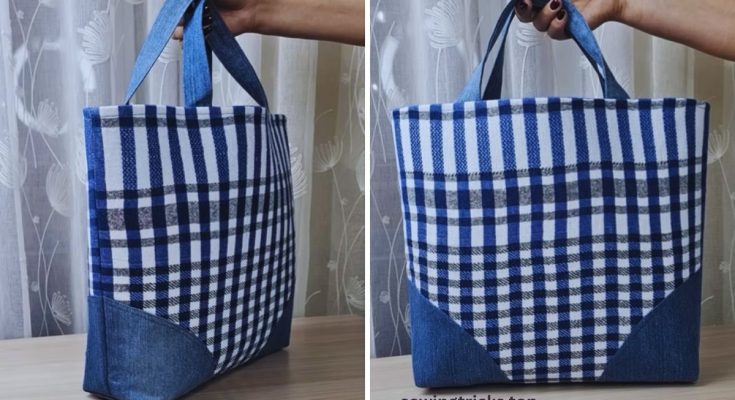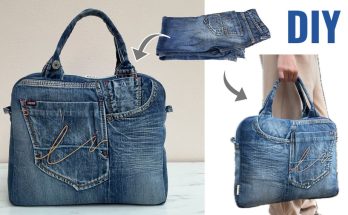This is a fantastic upcycling project! Combining the sturdy durability of old jeans with the lightweight, artistic beauty of a scarf creates a truly unique and practical large beach bag. This tutorial will guide you through the process in detail, suitable for someone with basic sewing machine skills.
We’ll aim for a bag that’s roughly 18 inches (45 cm) wide, 16 inches (40 cm) tall, and 6 inches (15 cm) deep – a generous size for beach essentials.
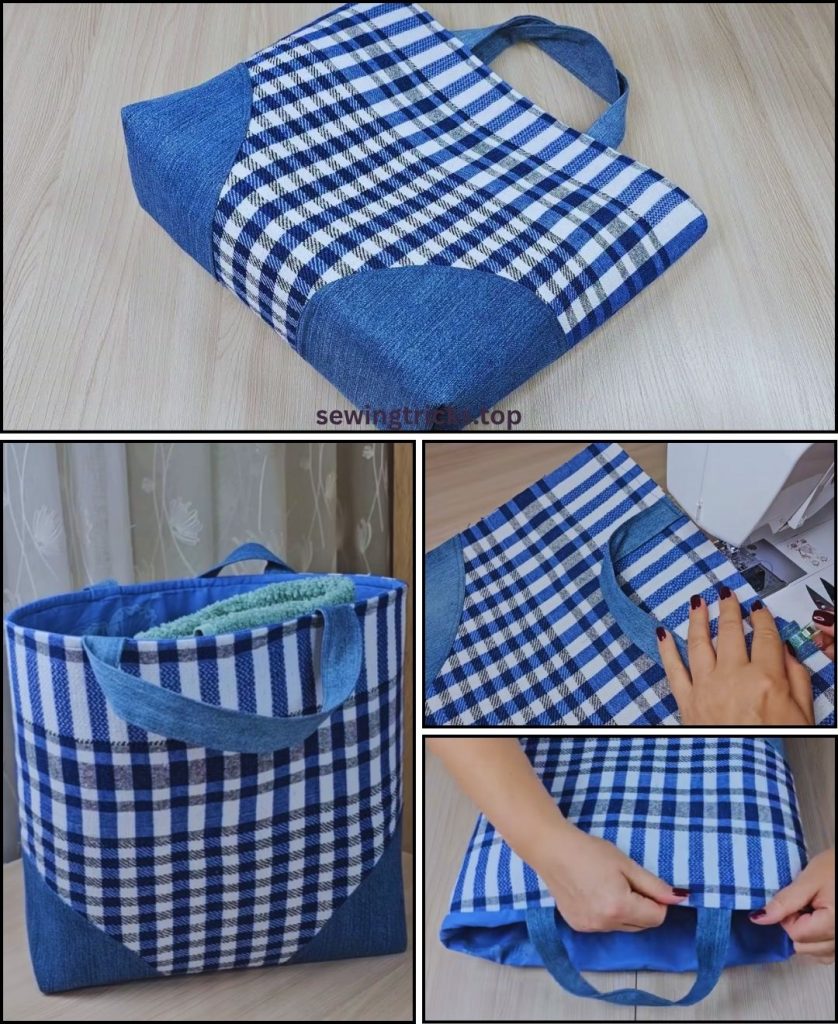
How to Sew a Large Beach Bag from a Scarf and Old Jeans
I. Planning & Gathering Materials
Careful selection of your materials will greatly impact the final look and durability of your bag.
- Old Jeans:
- Quantity: 1-2 pairs of adult-sized old jeans. The larger the jeans, the more continuous fabric you’ll get, which can simplify cutting.
- Type: Look for sturdy, non-stretch denim. Different washes (light, dark, faded) can add a cool patchwork effect. Avoid very thin or ripped-through jeans if you want a durable bag, unless you plan to reinforce those areas. The legs will be your primary fabric source.
- Preparation: Wash and thoroughly dry your jeans before cutting.
- Large Scarf:
- Size: You’ll need a large scarf, ideally a square one (at least 36×36 inches / 90×90 cm) or a large rectangular one. The bigger, the better for more design flexibility.
- Fabric Type: Lightweight, flowy fabrics are ideal for the scarf part of the bag – think chiffon, silk, rayon, cotton voile, or a lightweight polyester. These will drape nicely. Avoid thick, heavy scarves (like wool knits) as they can add bulk and be difficult to sew with denim.
- Pattern/Color: Choose a scarf with a pattern or colors that complement your denim. This is where you can add a real pop of personality!
- Preparation: Wash and iron your scarf.
- Lining Fabric (Optional, but highly recommended):
- Type: A durable cotton (quilting cotton, broadcloth) or even a water-resistant fabric like ripstop nylon or PUL for a truly beach-friendly, spill-proof interior.
- Quantity: Approx. 1 yard (0.9 meters) for a bag of the size mentioned.
- Preparation: Wash and iron.
- Interfacing (Optional, but recommended for structure):
- Type: Medium to heavy-weight fusible interfacing. This will add body and stability to both the denim and scarf sections, making your bag stand up nicely.
- Quantity: Approx. 1 yard (0.9 meters).
- Handles:
- Option 1: Webbing: 1.5 – 2 inches (3.8 – 5 cm) wide, about 1.5 yards (1.4 meters) total. Cotton or polypropylene webbing is durable.
- Option 2: Denim from Jeans: You can make sturdy handles from the jean waistbands or leg scraps.
- Option 3: Scarf Fabric (reinforced): If you want matching scarf handles, you’ll need to reinforce them heavily with interfacing and/or internal webbing to make them strong enough.
- Matching Thread: All-purpose polyester thread (heavy-duty thread is good for denim, but all-purpose works if your machine handles it).
- Basic Sewing Tools:
- Sewing machine (with a denim needle or heavy-duty needle, size 16 or 18, is highly recommended for denim layers).
- Walking foot (optional but highly recommended): For sewing multiple thick layers evenly.
- Sharp Fabric Scissors or Rotary Cutter and Mat.
- Measuring Tape or Long Ruler.
- Fabric Chalk or Mark-B-Gone Pen.
- Plenty of Pins or Fabric Clips (clips are great for thick denim!).
- Iron and Ironing Board.
- Seam Ripper (inevitable!).
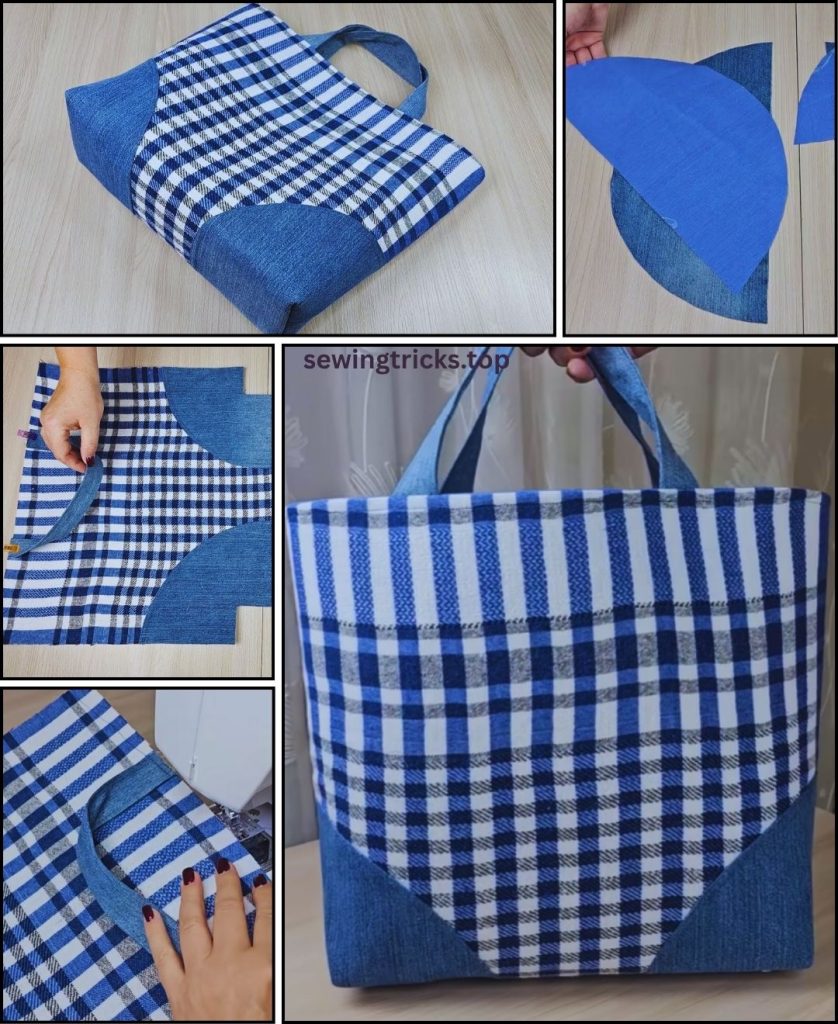
II. Prepare & Cut Your Fabric Pieces
Accuracy in cutting is key for a well-shaped bag. We’ll use a consistent 1/2-inch (1.27 cm) seam allowance throughout, unless otherwise specified.
1. Prepare Your Jeans
- Lay the jeans flat. Cut off the legs just below the crotch seam.
- Carefully unpick (seam rip) the inseam (the inner leg seam) and the outer leg seam of both legs. This will give you large flat pieces of denim. Press them flat.
- Harvest Pockets: If you want to use the back pockets of the jeans as exterior pockets on your bag, carefully cut them off, leaving about a 1/2-inch (1.27 cm) seam allowance around the stitched edges of the pocket.
2. Cut Main Bag Panels (Denim & Scarf)
- Denim Base (Bottom & Lower Sides): You’ll need two main rectangles for the bag body.
- From your flattened denim, cut 2 rectangles, 18 inches wide x 10 inches tall (45 cm W x 25 cm H). These will form the lower part of your bag.
- Scarf Top (Upper Sides):
- From your large scarf, cut 2 rectangles, 18 inches wide x 8 inches tall (45 cm W x 20 cm H). These will form the upper, decorative part of your bag.
- Lining Panels (Optional):
- From your lining fabric, cut 2 rectangles, 18 inches wide x 17 inches tall (45 cm W x 43 cm H). (Or 18″ W x 10″ H for denim bottom + 18″ W x 8″ H for scarf top if you want a pieced lining too).
- Interfacing:
- Cut interfacing pieces that are slightly smaller than your denim and scarf panels (e.g., 17″ W x 9″ H for denim and 17″ W x 7″ H for scarf, or even the full size and trim after applying if you prefer).
- Cut interfacing for the lining panels if you want a very structured bag.
3. Prepare Handles
- If using Webbing: Cut two pieces of webbing, each 25 inches (63.5 cm) long.
- If making Denim Handles: Cut two rectangles of denim, each 26 inches (66 cm) long x 4 inches (10 cm) wide. Fold each strip in half lengthwise (wrong sides together) and press. Open, fold raw edges to the center crease, press. Fold in half again and press. Topstitch both long sides. This will create strong, finished handles about 1 inch (2.5 cm) wide.
4. Apply Interfacing
- Following the manufacturer’s instructions, fuse the interfacing to the wrong side of your denim base panels and scarf top panels. This will give them stability. If using a delicate scarf, use a pressing cloth and low heat.
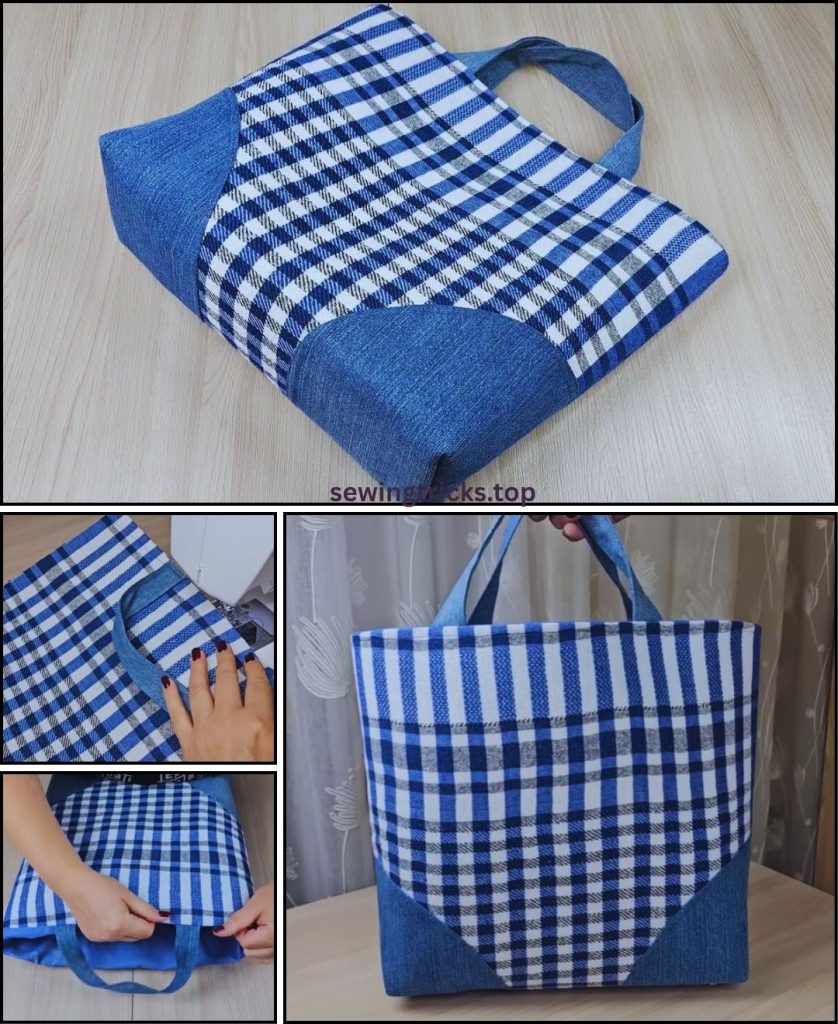
III. Let’s Start Sewing Your Beach Bag!
We’ll use a 1/2-inch (1.27 cm) seam allowance unless otherwise stated. Always press your seams after each step. Use your denim needle for all denim sections and a walking foot if you have one.
Step 1: Assemble the Exterior Bag Panels
- Take one Denim Base panel (18″ x 10″) and one Scarf Top panel (18″ x 8″).
- Place them right sides together, aligning one of the 18-inch edges.
- Pin along this edge. Stitch them together using a 1/2-inch seam allowance.
- Press the seam allowance open, or press it towards the denim (which is usually stiffer and helps it lie flat).
- Topstitch (Optional but Recommended): On the right side, topstitch along the seam line, just above the seam (on the scarf side) and just below the seam (on the denim side). This helps the seam lie flat and adds a professional touch.
- Repeat this process for the second set of Denim Base and Scarf Top panels, creating two complete exterior bag panels.
Step 2: Add Exterior Pockets (Optional)
- If using jean back pockets:
- Decide where you want to place the pocket on one of your assembled exterior bag panels (e.g., centered on the denim section).
- Place the pocket on the panel, ensuring it’s straight and centered. Pin in place.
- Stitch the pocket onto the bag panel close to the edge of the pocket, reinforcing the top corners with a small triangle or bar tack for durability.
Step 3: Attach Handles
- Take one assembled exterior bag panel. Lay it right side up.
- Measure 4 inches (10 cm) in from each side edge along the top of the scarf section. Mark these points. These are where your handles will be attached.
- Place the raw ends of one handle onto these marks, aligning the raw edges of the handle with the raw top edge of the bag panel. The handle loop should face downwards onto the bag panel.
- Pin securely. Stitch the handles in place with a strong reinforcing stitch (e.g., stitch a square with an “X” inside it) within the 1/2-inch (1.27 cm) seam allowance.
- Repeat for the second handle on the second exterior bag panel.
Step 4: Assemble the Exterior Bag
- Place your two assembled exterior bag panels right sides together, aligning the side seams and the bottom raw edges. Ensure the scarf/denim seams match up perfectly.
- Pin securely along the side seams and the bottom raw edge.
- Stitch down both side seams and across the bottom seam, using a 1/2-inch seam allowance. Backstitch at the beginning and end of each seam.
- Finish Raw Edges (Optional but Recommended): Use a zigzag stitch or serger along all raw seam allowances to prevent fraying and add durability. Press seams open.
Step 5: Create Boxed Corners for Exterior Bag
This gives your bag a flat bottom.
- At one of the bottom corners of the exterior bag (still inside out), pinch the corner so the side seam and the bottom seam align perfectly, forming a triangle.
- Measure from the point of this triangle inward along the seam line a distance equal to half of your desired bag depth (e.g., for a 6-inch deep bag, you’ll measure 3 inches / 7.6 cm).
- Draw a straight line perpendicular to the seam at this measured point. This line should be 6 inches (15 cm) long (the total depth of your bag).
- Stitch precisely along the drawn line, backstitching securely at both ends.
- Trim the excess fabric from the corner, leaving about a 1/2-inch (1.27 cm) seam allowance beyond your new stitching line.
- Repeat this exact process for the other bottom corner of the exterior bag.
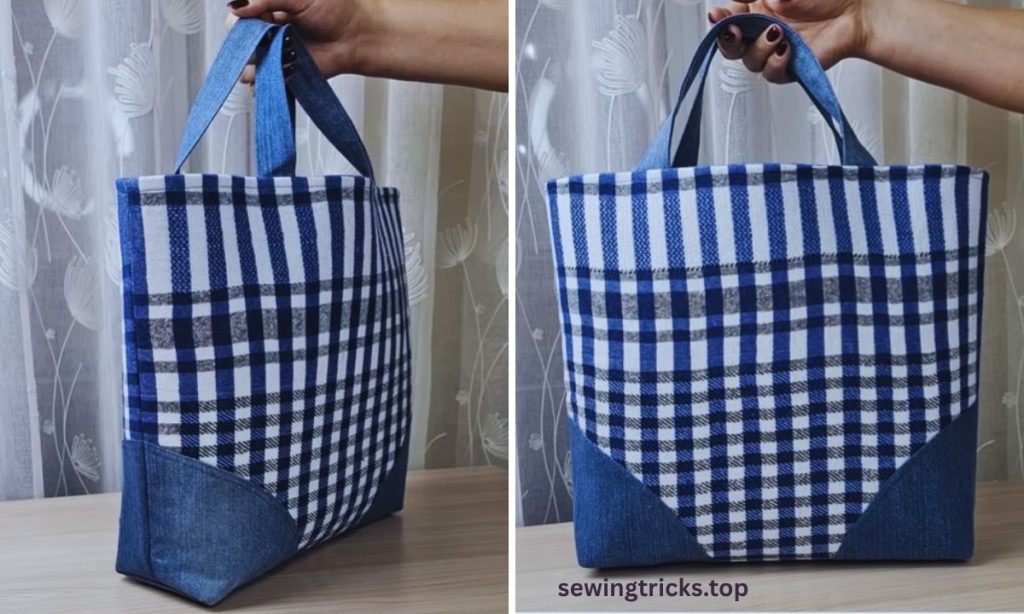
Step 6: Assemble the Lining Bag (Repeat steps 4 & 5, with one modification)
- If you’re using a single lining piece (18″ W x 17″ H), skip Step 1 for the lining.
- Place your two lining fabric panels right sides together.
- Stitch down both side seams and across the bottom seam, using a 1/2-inch seam allowance.
- IMPORTANT: Leave a 4-5 inch (10-12.7 cm) opening along the center of the bottom seam of the lining. This opening is crucial for turning the bag right side out later. Backstitch well at the beginning and end of this opening.
- Create boxed corners on the lining bag just like you did for the exterior bag (Step 5).
- Do NOT turn the lining bag right side out. Keep it inside out.
Step 7: Combine Exterior and Lining
- Keep the exterior bag turned right side out.
- Keep the lining bag turned inside out.
- Carefully insert the exterior bag into the lining bag, so that the right sides of both bags are facing each other.
- Align the top raw edges of the exterior bag and the lining bag. Make sure the side seams of the exterior match up with the side seams of the lining. The handles of the exterior bag should be tucked down between the exterior and lining layers.
- Pin securely all around the top raw edge of the bag.
Step 8: Sew Top Edge and Finish
- Stitch all the way around the top edge of the bag, using a 1/2-inch seam allowance. Backstitch at the beginning and end.
- Clip curves/corners: If you have any slight curves, clip into the seam allowance (without cutting stitches) to help the seam lie flat when turned.
Step 9: Turn Bag Right Side Out & Close Opening
- Reach into the opening you left in the bottom seam of the lining (from Step 6).
- Slowly and carefully pull the entire bag (exterior, lining, handles – everything!) through this opening until it is completely right side out.
- Gently push out all the corners of the main bag and the lining, using a point turner or a blunt object (like a chopstick) to get them crisp and well-defined.
- Close the Lining Opening: Go to your ironing board. Press the raw edges of the opening in the bottom of the lining under by 1/2 inch (1.27 cm) so they meet neatly. Align these pressed edges and pin or clip them together. Stitch this opening closed by machine (sewing very close to the folded edge for a neat finish) or by hand using an invisible ladder stitch for a truly seamless look.
- Finally, push the lining down into the main bag, ensuring it sits smoothly inside and the corners align.
- Give your finished bag a good final press to remove any wrinkles and make it look crisp.
Congratulations! You’ve successfully sewn a unique and eco-friendly large beach bag from a scarf and old jeans. It’s ready for all your sandy adventures!

